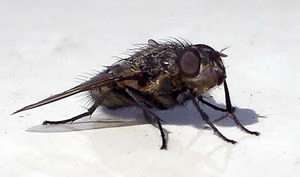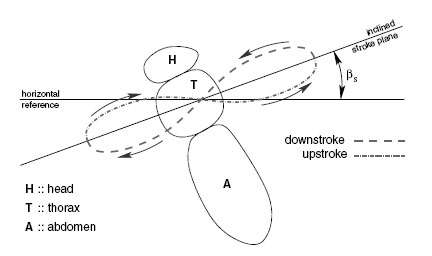August 28, 2006 feature
Flies provide aerodynamic model for tiny flying vehicles

When it comes to flying, the fly reigns supreme. This two-winged insect’s sophisticated flying behavior enables it to make sharp turns, aim at targets and hover – traits which make the insect an ideal prototype for tiny micro air vehicles (MAVs). However, the same flying finesse also presents challenges for scientists trying to investigate, observe and understand these complex creatures in their natural environments. Now, scientists from the U.K. demonstrate that mathematical modeling may provide adequate complementary information for advances in MAV technology.
Airplane technology has been evolving for more than 100 years, with much attention to size increase: In 2005, for example, the Airbus380 was unveiled. The plane can carry up to 800 people and is as long as a football field.
On the other end of the spectrum, MAVs – which scale down to around 150 mm, about 10 times larger than a real fly – have only emerged in science labs since the late ‘90s. Because the aerodynamics of airplanes don’t work for such minute flying machines, engineers and biologists have looked to nature to mimic her millions-year-old evolution of insect aerodynamics.
Up to now, scientists have primarily learned about insects’ flying behavior empirically – for example, by tethering flies inside a virtual reality cage and manipulating the flies’ environment to observe flight patterns and motions.
“[Tethering means that] insect behavior may differ from free flight,” wrote Rafal Zbikowski, Salman Ansari and Kevin Knowles in a recent issue of the new journal Bioinspiration and Biomimetics. “Further progress, especially in the context of MAVs, can be achieved by the complementary information derived from appropriate mathematical modeling. The focus here is on a means of computing the data not easily available from experiments and also on making mathematical predictions to suggest new experiments.”

One type of modeling the scientists demonstrate concerns the “six degrees of freedom” motion, which refers to the ability to move forward, backward, left, right, up and down, as well as rotate in directions called yaw, pitch and roll. The fly, like a plane, can move and rotate in each of these directions, but it flaps its single set of wings more akin to oars on a rowboat than airplane wings. Flapping nearly 200 times per second, its wings move in a figure-eight motion perpendicular to its body.
“The motion of a flapping wing differs from conventional aeroplane rotorcraft wings in that it starts from rest, accelerates to some roughly constant speed, and then decelerates to rest again,” the scientists explained.
The fly achieves its flight and keen maneuverability due to complex airflow created by the highly angled wings when they stop at the high and low points (halfstrokes) of the figure-eight path (see figure). At these points, the wing rotates rapidly, creating peaks of lift force due to a special vortex system. Further complexity arises because the wings continually pass back and forth through their own wake, capturing energy from previous strokes and complicating scientists’ traditional aerodynamic theories.
In their paper, Zbikowski, Ansari and Knowles presented a sample model of the fly in hover mode with aerodynamic modeling, for the first time accounting for the non-linearity due to the fly’s complex wing kinematics. The team found good agreement when comparing their model with data from experiments by Michael Dickinson, known for his fabrication of Robofly – a motor-powered, stainless steel robot controlled by a computer.
“Since the aerodynamic force and moment production in insects is periodic, it is relevant to consider special mathematical tools,” the team concluded, noting that periodicity only describes part of insect flight. “Indeed, if all solutions of the equations of motion were periodic, straight line flight (observed clearly in hoverflies) would not be possible. On the other hand, butterflies often fly ‘erratically’ which may mean that they employ quasi-periodic (or even chaotic) solutions in order to avoid capture by predators.”
Scientists foresee a wide range of applications for tiny flying robots based on insects: for starters, MAVs could have uses in search and rescue missions (such as in burning buildings), spying, sensing dangerous chemicals and space exploration. Since MAVs should be inexpensive to manufacture after the technology is developed, they could conceivably be exploited for many as-yet-unthought-of everyday applications, as well.
Citation: Zbikowski, Rafal, Ansari, Salman, and Knowles, Kevin. “On mathematical modeling of insect flight dynamics in the context of micro air vehicles.” Bioinspiration and Biomimetics. 2006. 1 R26-R37.
By Lisa Zyga, Copyright 2006 PhysOrg.com, Photo credit: FreeDigitalPhotos.net





















